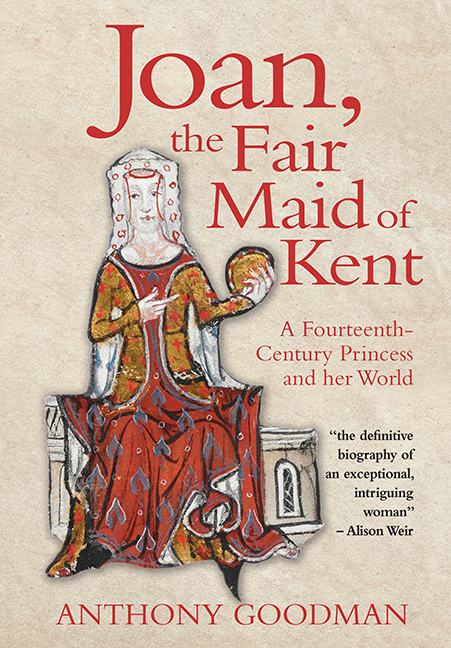Book contents
- Frontmatter
- Dedication
- Contents
- List of Illustrations
- List of Abbreviations
- Maps
- Genealogical Tables
- 1 Loosened Bonds
- 2 Tragic Beginnings
- 3 Bigamy
- 4 Married Bliss
- 5 A Whirlwind Rom
- 6 Princess of Wales and of Aquitaine
- 7 Deaths of Princes
- 8 The King's Mother
- 9 Terrors and Tribulations
- 10 Venus Ascending?
- Notes
- Bibliography
- Acknowledgements
- Index
- Frontmatter
- Dedication
- Contents
- List of Illustrations
- List of Abbreviations
- Maps
- Genealogical Tables
- 1 Loosened Bonds
- 2 Tragic Beginnings
- 3 Bigamy
- 4 Married Bliss
- 5 A Whirlwind Rom
- 6 Princess of Wales and of Aquitaine
- 7 Deaths of Princes
- 8 The King's Mother
- 9 Terrors and Tribulations
- 10 Venus Ascending?
- Notes
- Bibliography
- Acknowledgements
- Index
Summary
JOAN'S PROSPECTS in her early teens were bright. She was a close kinswoman of the king. There coursed through her veins the blood of the Emperor Charlemagne and of St Louis (Louis IX of France), as well as that of William the Conqueror. She was hailed as exceptionally beautiful. She was her brother John's prospective heir. It was, however, to be anticipated that, if he survived into adulthood and fathered an heir, she would not bring the great prize of the earldom of Kent to a suitor. Nevertheless, she would still receive a dowry commensurate with her high birth. Since John was under age, his wardship was in the king's gift, and it was therefore the king's right either to arrange her marriage, or to bestow the right to arrange it on whomever he wished.
However, Joan's first marriage did not by any means conform to the king's or her kinsfolk's likely plans. When she was in her early teens, or even younger, she married a certain Sir Thomas Holand, in about 1339 or 1340 according to later testimony. Then probably in his early to mid twenties (born c. 1315), he was a promising young man. We can infer from his subsequent career that he had shown exceptional youthful fighting skills. In 1338 Thomas had been appointed as a knight of the king's household. How had he gained a knighthood? Possibly he had given good service in the king's wars in Scotland, perhaps serving there under his elder brother Sir Robert.
According to the findings of a later ecclesiastical tribunal, which were to be universally accepted, Thomas and Joan were married privately, before witnesses, but without the calling of banns or a public ceremony of blessing. In such cases, the marriage was perfectly valid in ecclesiastical law. Moreover, the tribunal accepted too that the couple had consummated their union. This marriage was a secret one, contracted without the knowledge of Joan's family or the king or queen. It remained secret. From the prevailing point of view in society, this manner of marriage showed Joan to be a disobedient and undutiful girl, whose headstrong and devious behaviour marked her out as being prey to the weaknesses considered as natural to her sex.
- Type
- Chapter
- Information
- Joan, the Fair Maid of KentA Fourteenth-Century Princess and her World, pp. 22 - 41Publisher: Boydell & BrewerPrint publication year: 2017

